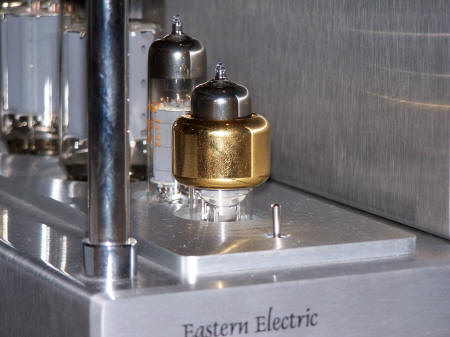You are reading the older HTML site
Positive Feedback
ISSUE
25
may/june
vintage tube services
Original Mini Tube Dampers
as reviewed by John Mazur

|
You are reading the older HTML site
Positive Feedback
ISSUE
25
vintage tube services Original Mini Tube Dampers as reviewed by John Mazur
|
|
|
There are quite a few vacuum tube dampers on the market these days. The goal of tube dampers is to minimize microphonic feedback, which results from a tube’s sensitivity to acoustic signals or vibration. When the tube then amplifies or conducts that signal, the result is sonic degradation. Tapping a tube gently with a pencil will reveal whether it is microphonic—if it is, the tapping will be heard through the loudspeakers. Some tube dampers consist of rubber or silicone O-rings that fit over the tube, while some are sleeves that cover the entire glass envelope. Some sleeves are also used to shield small-signal tubes from radio-frequency effects. A while back, I used spring-secured metal tube dampers, which had to be balanced on the points of brass cones that were placed on the sides of the tubes. I was always apprehensive that a coiled spring would let go while I was listening to music, and cause a catastrophic event. I was also unsure of the advantages of such precariously perched dampers. I tried to replace them with silicone O-rings, but decided not to use those when I discovered that they would stick to the tubes, and were not re-useable. During a recent equipment review, I experienced a distortion problem that first had me wondering whether I had a blown speaker driver. Further examination revealed a vacuum tube that was conducting microphonic signals coupled from the listening room. After the tube was replaced, the wonder of microphonics was revisited since I was not listening at loud, rock concert volumes. I remembered seeing some brass sleeves in a well-known mail order catalog that were being touted as tube dampers. I called the company and when I was told that the product was discontinued, further questioning revealed that the product was from Vintage Tube Services. (www.vintagetubeservices.com).
A call to VTS revealed that the Original Mini Tube Dampers are not mass-produced, but hand-made, and that I would have to wait for Andy at VTS to have enough orders to make a production run worth his time. Andy is passionate about tubes, tube equipment, and tube history. He is also very particular, so you can be assured that anything you buy from him will be thoroughly tested. The gold-plated brass sleeves of the tube dampers are about one inch tall, with two rubber O-rings set into two grooves inside the sleeve. Anyone can call an O-ring a tube damper. In the Original Mini Tube Dampers, Andy combines the damping of O-rings with the mass of the brass sleeves. The Original Mini Tube Dampers are available for both small-signal and octal-type tubes. The price is $120 per pair, though this may go up due to the rising cost of metals. Installing the Original Mini Tube Dampers is straightforward. Both the tube and the sleeve need to be warmed up prior to installation. With the tube out of the socket, and held in a rag for safety, the damper is slid midway onto the tube. If any difficulty is experienced, Andy says that rubbing the tube with your hands will help the process. Be warned that the dampers can rub the label off the tube. Also, the dampers might not fit on some current Chinese and Russian tubes, as they may be too large. On the 5687s used in the Artemis Labs LA-1 preamp, the dampers fit snugly, but they were easy to slide onto the Mullard E80Fs on the Eastern Electric M520 integrated amp. Once installed, I was immediately convinced of the improvements I was hearing, on both the LA-1 and the M520. Focus was improved, and images were better defined. It was like removing a soft-focus lens from a camera. Bass notes were more solid and fast. The soundscape had better clarity. I didn’t notice any change in the high frequencies. The dampers also looked great. I am sold on this product. Andy is a great guy to deal with, and the Original Mini Tube Dampers does what he says they do. Be patient when you place your order, and you will be rewarded with a tool that will bring your system performance up a full notch. John Mazur
Original Mini Tube Dampers |